San Francisco passed a landmark ordinance earlier this year, which mandates that information about RF radiation exposure, a WHO class 2B carcinogen, be present at all cell-phone retail sites in the city, and given to buyers. If such an ordinance were passed to inform people about their exposure to RF from “smart” meters, what might the poster look like…?
The SF cell-phone right-to-know ordinance was put into effect on Sept. 30, with retailers to be given about three weeks to get into compliance. However, only a few days passed before the CTIA embarked on a lawsuit to stop the city instituting the ordinance. [UPDATE: CTIA appeals even the toned down version approved by Fed judge after first appeal.] The grounds? Infringement of the wireless industry’s freedom of speech. See below for when and how to protest this latest corporate obstruction of civil governance.
Information is the greater part of education—context and the tools of analysis making up the rest. But to start with information is crucial. Here are the details of SF Dept of the Environment’s ordinance. So what information does the new ordinance say must be given to those customers browsing or buying cell phones? Below are images of the poster (11×17 inches, displayed in store), fact sheet (comes with phone), and little sticker (to be displayed on spec sheets of phone features in the store).
But the twist is, I also have the drafts that–just five days before the ordinance went into effect–were the materials touted during a public workshop by the Dept. of the Environment as being under consideration. There is quite a difference from draft to final version in each of the items. The final versions are less emphatic, much more tentative, less bold—in all, just a little “nicer.” Well, SF, it didn’t really pay to “play nice” with the industry—they still slapped the city with a lawsuit. (Draft version on the left, final on the right.)
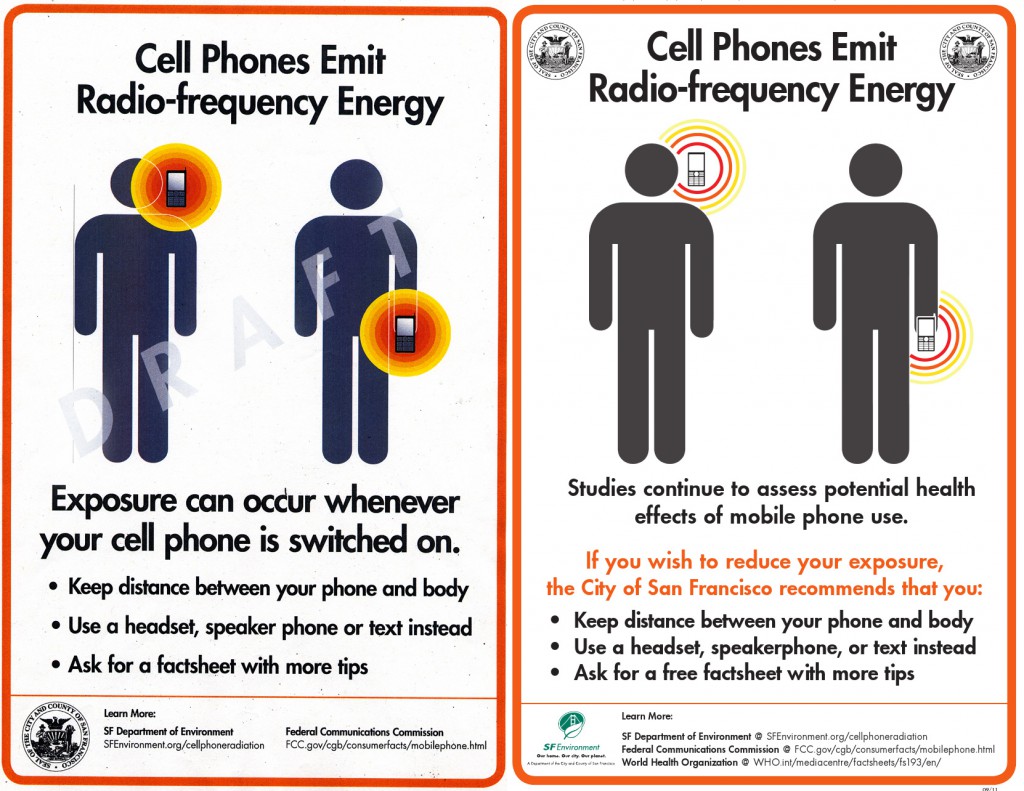 The Draft makes a clear & true statement about something that most people don’t know: “Exposure can occur whenever your cell phone is switched on.” The first statement on final is the usual mealy-mouthed sowing of uncertainty: “Studies continue to assess…”
The Draft makes a clear & true statement about something that most people don’t know: “Exposure can occur whenever your cell phone is switched on.” The first statement on final is the usual mealy-mouthed sowing of uncertainty: “Studies continue to assess…”
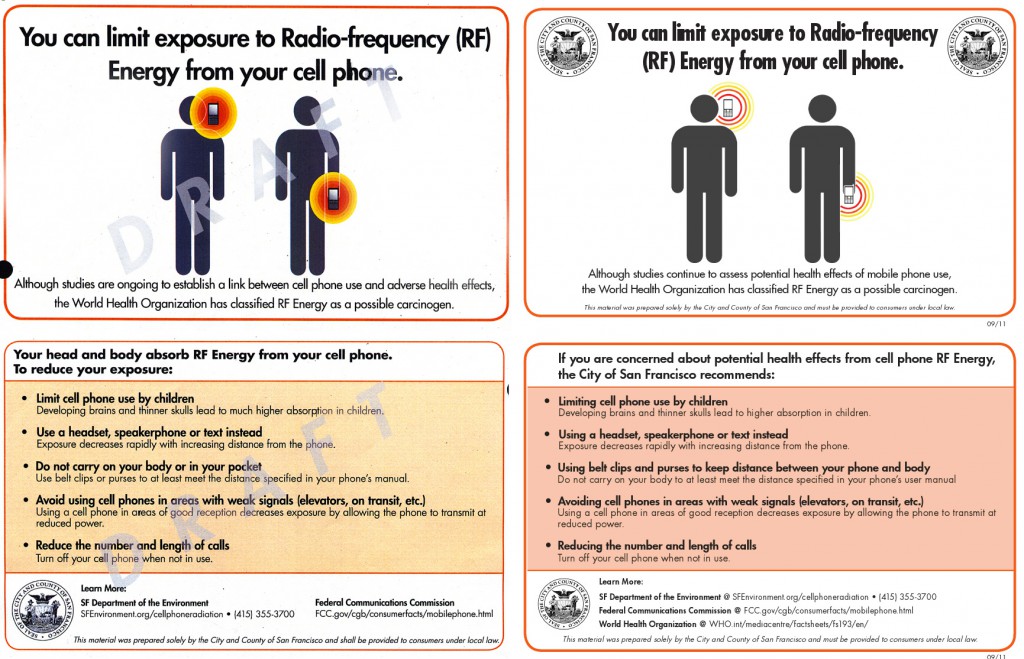 The change in font on the final version of the Factsheet (8.5×11 inches) makes the message at the top harder to read. The third recommendation on the draft, “Do not carry on your body or in pocket,” is changed to something messier and less definitive: “Use belt clips [a la nerd-style] …or purses [teen girls use back pockets because they don’t carry purses!] ”
The change in font on the final version of the Factsheet (8.5×11 inches) makes the message at the top harder to read. The third recommendation on the draft, “Do not carry on your body or in pocket,” is changed to something messier and less definitive: “Use belt clips [a la nerd-style] …or purses [teen girls use back pockets because they don’t carry purses!] ”
And those little glow-circles of radiation just look so much less, well, radio-active, on the final versions! Practically sunny. They all but disappear behind the bodies.
 This is the sticker, about life-size. It is required to go on any papers listing phone features. The draft version is an effective and bold use of a black background–it stands out. The final includes the niced-down phrase “If you wish….”
This is the sticker, about life-size. It is required to go on any papers listing phone features. The draft version is an effective and bold use of a black background–it stands out. The final includes the niced-down phrase “If you wish….”
All of this raises in my mind the obvious issue of why San Franciscans and all of the rest of us don’t have the right to know about the true nature of the RF radiation that the “smart” meter emits. A cell phone at least comes with a manual.
PROTEST this intrusion of corporate power on one city’s attempt to educate its citizens: The court case against this right-to-know ordinance is to be heard on Thursday October 20, 8:00 am, at the Courthouse, 450 Golden Gate Ave, SF. Please join us!

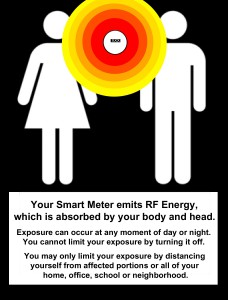
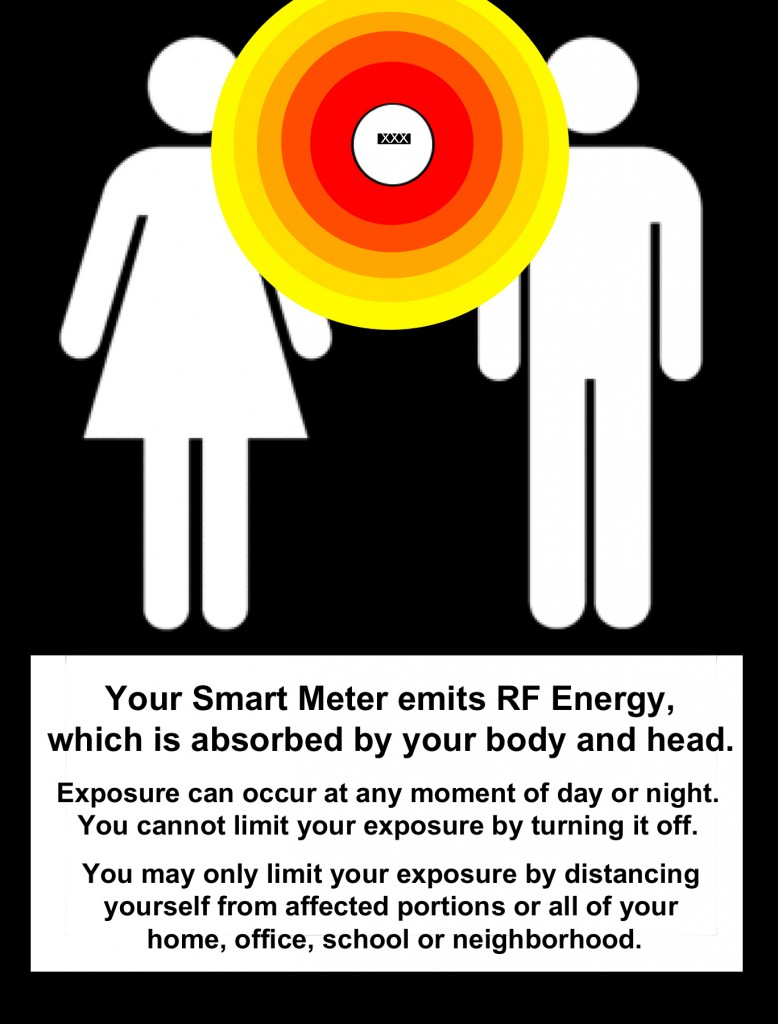
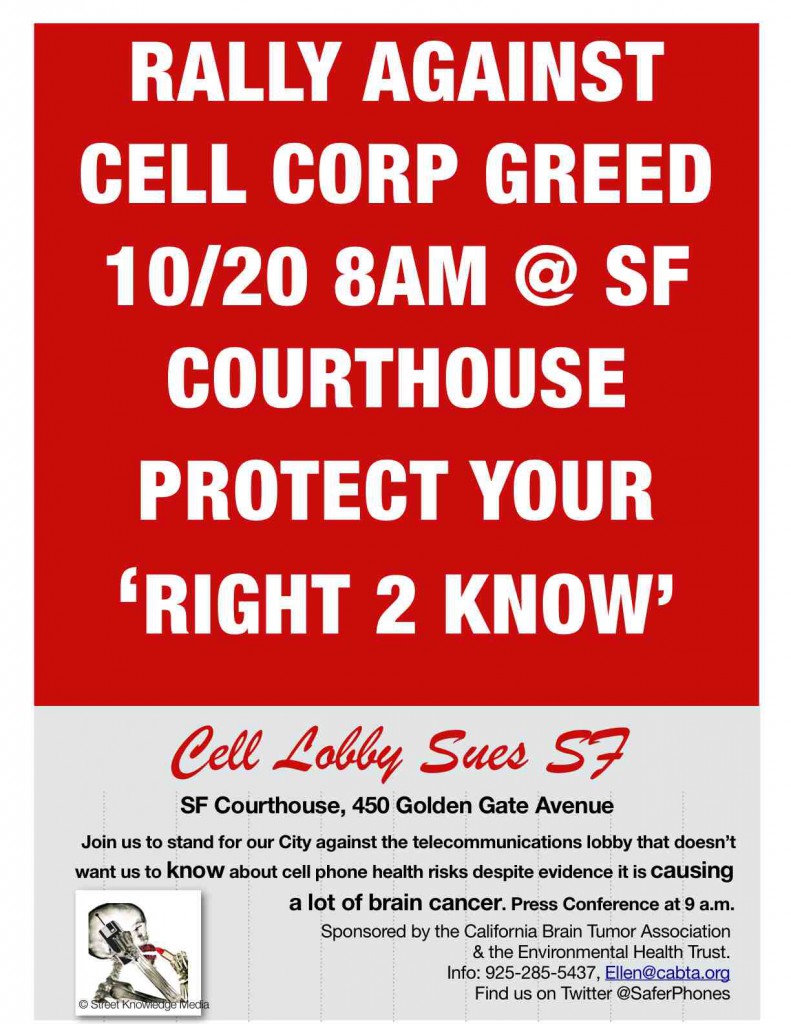
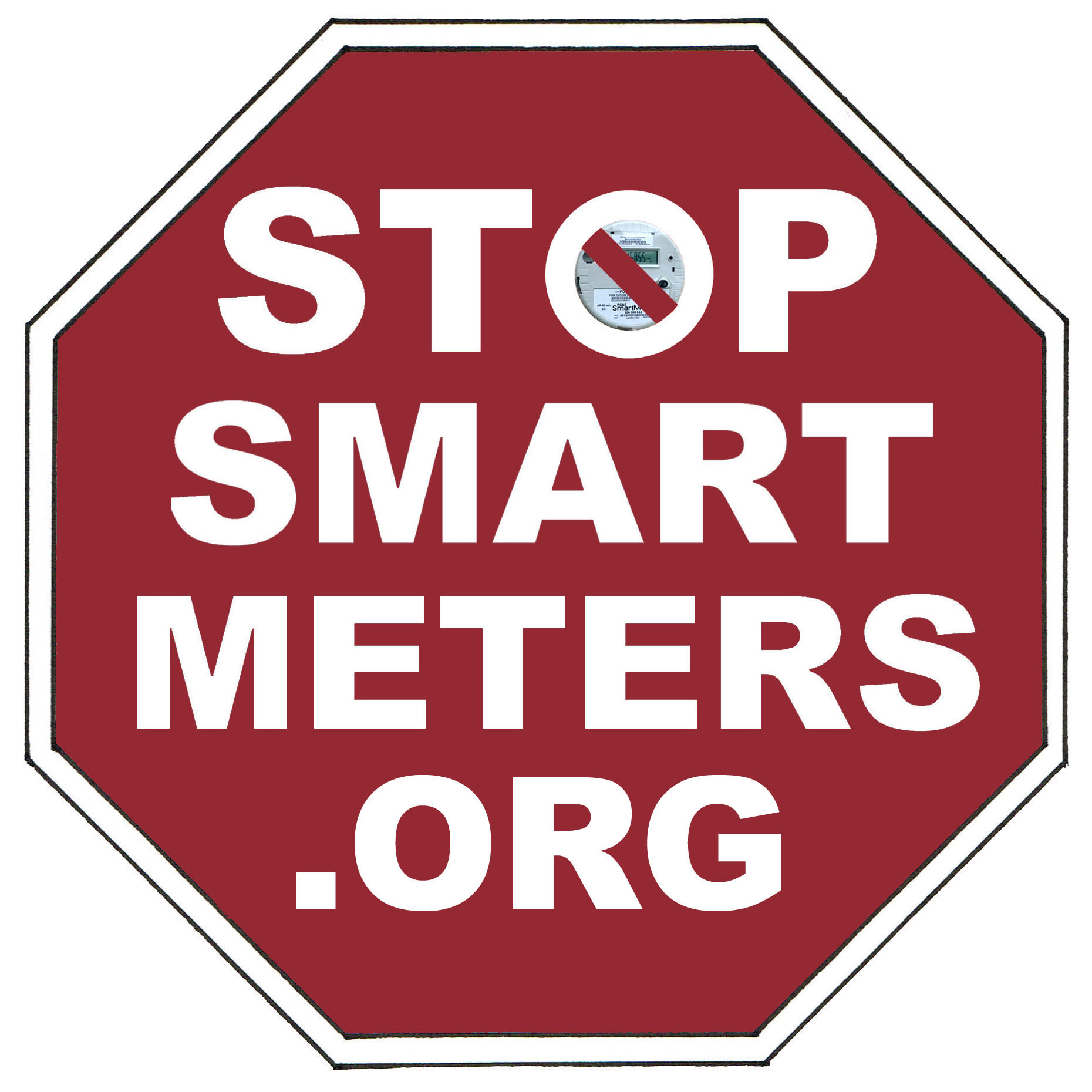
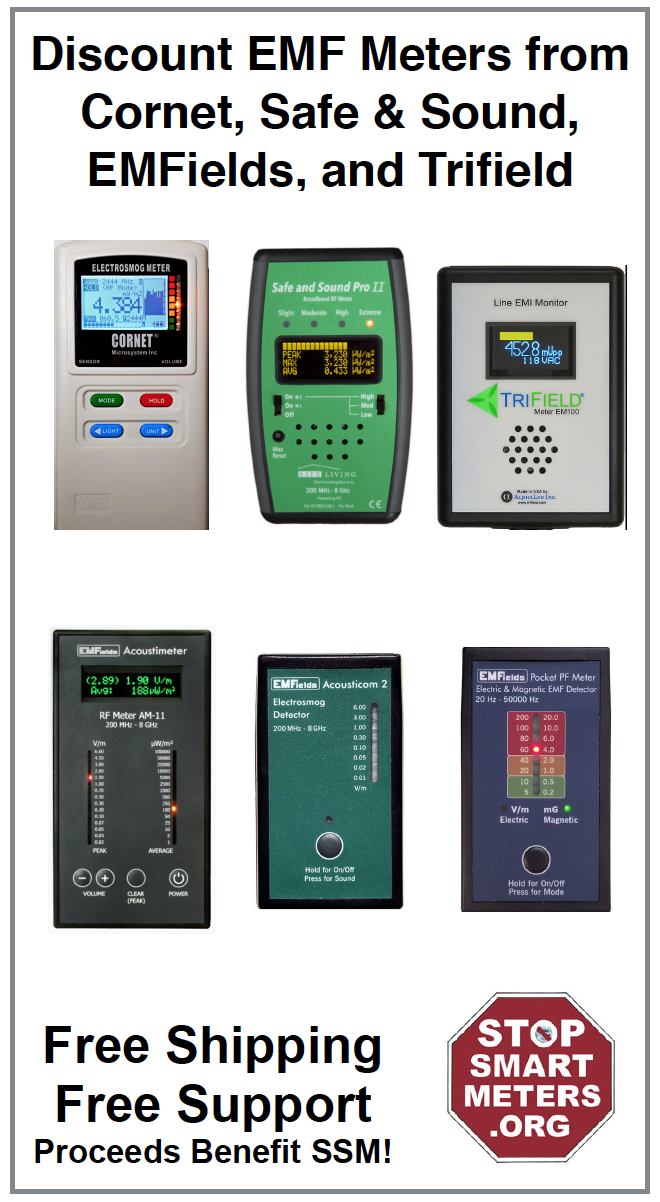
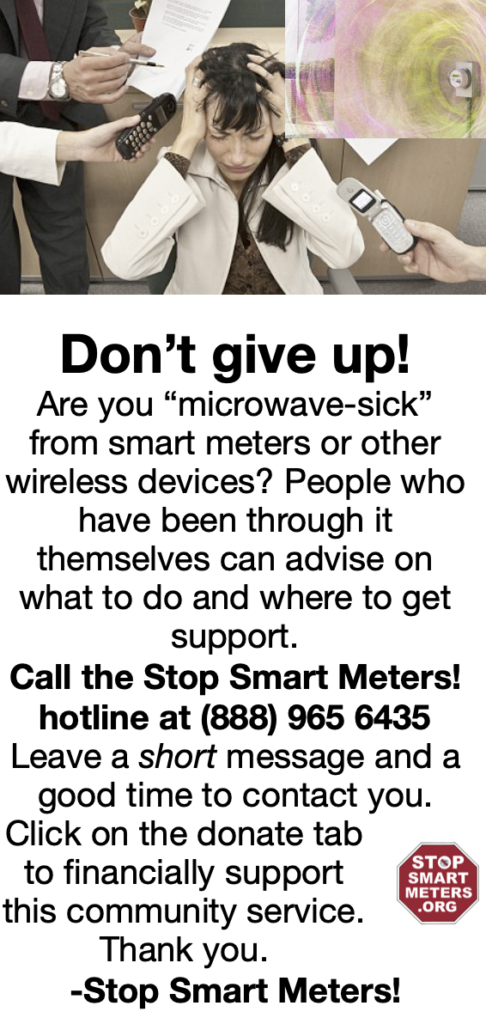
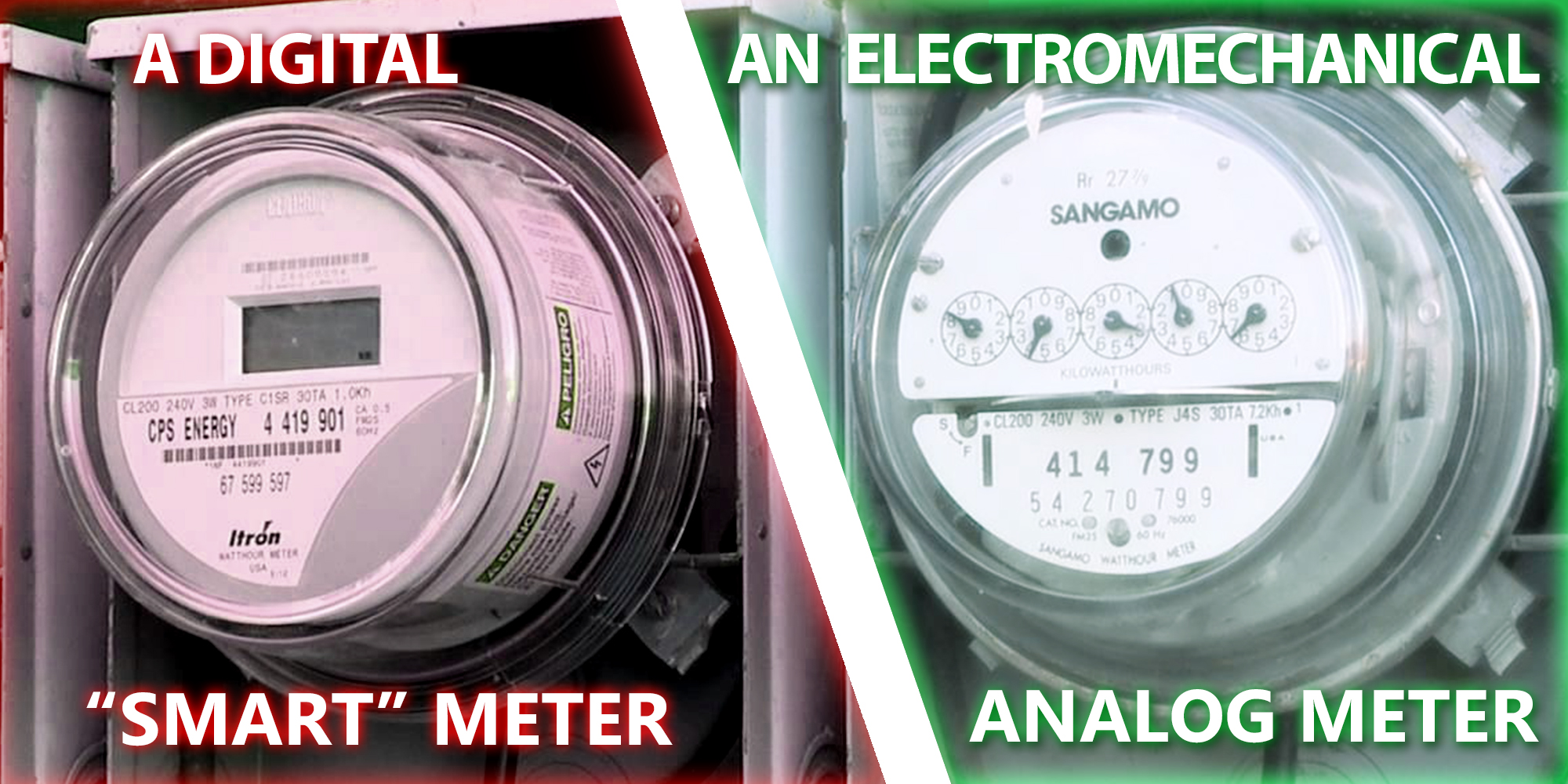



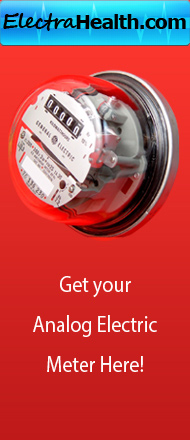
They will probably take this down so you might want to save the info.
Full specs on all their meters are available at the site. And I am sure at the manufactures’ sites too. (comments after the quotes are mine)
“One-watt transmitter provides full, two-way wireless communications” – ONE WATT!!! That’s WAY, WAY, WAY more than a cell phone!
“Enables over-the-air firmware upgrades and Communications Module programming to reduce expenses” – Ready to be reprogrammed by the power company or HACKER, BY REMOTE at any time, maybe the power company can change the reading math equations to make a little more $$, they are not greedy though, no really they aren’t, the execs that get only a little pay for their time will tell you this. And if you report them they just change it back FROM REMOTE before anyone tries to inspect the meter.
“Supports Advanced Metering and Demand Response functions” Time of use billing, shutting off loads (any enabled appliances) from remote OR DISCONNECTING YOU FOR NON PAYMENT! Or maybe if you mouth off to someone in billing on the phone?
“Provides full security and encryption to meet rigorous industry standards” Completely hacker proof, just like the Department Of Defense computers and their flying drones! Oh wait….
“access to both logged and instantaneous data. ” – Let the burglars know you aren’t home and possibly get your daily schedule from “logged data”!
http://www.silverspringnet.com/products/emeters-ge-I-210+.html
More good cell phone news, Palo Alto is getting 60 new mobile phone transmitter sites real soon. Why do they need these new sites ?
Because the new mobile phones only put out 200 milliwatts (2 tenths of a watt) now, and they need more towers to compensate for the lower power of the handheld devices (think-dropped calls).
So if a modern mobile phone puts out only 200 milliwatts, and Silver Springs Networks advertises that their mesh network in the new E1 residential radio electric meters put out one watt, that means that their meters are 5 times as powerful as a mobile phone.
If indeed the transmitters in the new meters put out 1 watt, (they are transmitting 24/4, but only send total usage data once every 4 hours to the utility radio revenue collection computers), the rest of the time they are basically transmitting for nothing.
So, PG&E has 10 million electric meters that they want to convert to a radio billing system, and they each use 1 watt, that is 10 million watts of RF that requires 12.5 million watts of electrical energy to transmit that RF. That will be 12.5 million watts per hour times 24 hours equals 300 million watts per day just to power the transmitters of the new meters alone, then there are the data collectors, repeaters, servers in the billing dept. (revenue assurance).
It’s funny how they claim that by having automated meter reading it can somehow save customers energy, because the opposite is true, the new meters use large amounts of energy per day to eliminate meter reading jobs. Next PG&E will be crying to the CPUC to raise our electric rates again to build more power plants to power the new meters, or, they will ration power with rolling blackouts.
I read a very informative article in the Industry Watch section of Electrical Contractor magazine. They explained that an electric utility with 1 million customers (meters) can save $8 million dollars per year for 10 years by switching to automated meter reading and eliminating the labor costs, saving the corporations money, but not the customers anything !
So, if PG&E has 10 million meters, they can save $80 million dollars per year for 10 years equals $800 million, and the automated (smart) meter program costed the RATEPAYERS $2.2 BILLION to fund this meter project alone, obviously many people in the government, PG&E and the meter manufacturers, installers, shippers and sales people made a lot of money off of this deal. And then add the marketing of the HomePlug-ZigBee alliance to market the Home Area Networks systems to customers who can afford it, and the Federal Stimulus money given to the appliance manufacturers to install usage reporting transmitter chips in some major appliances, the economy is doing quite well, ain’t it ?
Amy, also note the toned down colors on the second version, which call less attention or alarm to the information!
Is is okay if we use your smart meter graphics for signs, etc.???
Please help yourself. There is also a new page with other images and stuff for flyers, click FAQ above, then ‘Organizing’ section.
The new E1 “smart” meters are just slaves, the master controller is PG&E, who dictates commands to disconnect power over a radio network. The meters do not know if someone has not paid their bill, they need to be told and ordered to activate the motorized disconnect switch inside the meter to cut the power coming out of the meter to feed the building. And that is their only remotely controlled switching function that they can do. They cannot control any appliance inside the building at this time, but in the future the slave meter will hoped to be able to control a special “enabled” thermostat that can turn a compressor motor on and off via the 24 volt control wire to the air conditioning unit if the customer chooses to to allow it. It can easily be overridden at the thermostat or by jumping the blue pair of wires in the thermostat terminal block. That is the only thing inside any building that will be remotely controlled via the radio network from the power company, and that is not interactive control, it is one way only. The meters themselves are simple and stupid slaves, and are not capable of controlling anything alone, they are slaves and need commands from a master controller !
The meter program is a waste of customers money and energy to eliminate meter reading jobs, and also is bombarding the public with unnecessary RF. It’s all about marketing. Anyone who believes all the industry marketing brochures, web sites and commercials has been brainwashed, and has no credibility anywhere. And of course all the kooks who think that the meters can monitor and control individual appliances have no credibility either, the meters control NOTHING! .
Found this using Google. It’s amazing what you can do when you use the search feature there.
“This is the first step towards an exciting energy future where you’ll be able to view your electricity use through a browser on your smart phone and turn off or on the electricity flow to various devices. In the future you will be able to work with energy management partners (such as Google) and your retail electric provider to help better manage your use and reduce your energy consumption. In this not-so-distant frame, you’ll be able to tell if Junior left the TV on and turn it off from afar (and send him a nagging text message of course). Or maybe you realize you’re getting off work early; you’ll be able to go ahead and set your thermostat so the house will be nice and cool by the time you get home. The technological possibilities of smart meters will eventually offer us radically more control of our energy use, which will decrease overall pollution from power plants, the need for new power plants to be built, and of course our energy costs.”
“allows customers to track their energy usage in 15-minute increments to better understand their usage patterns and potentially decrease their electricity consumption and costs.”
From the CURRENT power company site, smartmetertexas DOT com “SMT also allows you to view the HAN Devices that have been added to your Smart Meters.”
So not a stretch to say it could control them too! (HAN = Home Area Network)
From the FAQ “A HAN Device is a piece of equipment with the intelligence to receive informational messages and commands from your Retail Electric Provider (REP) to help you manage and control your energy consumption. Examples of HAN Devices include in-home display, thermostats, and smart appliances.”
“commands from your Retail Electric Provider” <<<<< Yup!
http://texasvox.org/2010/03/24/texas-smart-meter-portal-goes-live/
Obviously, that is a marketing promotion by some newer manufacturers trying to sell their products that they claim will be available in the future, but all those features have been available for decades from Lutron ( HomeWorks, GraphicEye 24 volt wired), and RadioRA wireless. Leviton makes Decora Home Controls (DHC) powreline carrier systems, and a variety of other commercial and industrial controls including sub meters that are capable of measuring electricity consumed on individual circuits, no chips needed. On large appliances like water heaters and electric clothes dryers, they each have a dedicated 30 amp circuit, and refrigerators are supposed to have a dedicated 20 amp circuit. Any other appliance needs to have a monitoring chip installed in it to be individually monitored by any automation system.
Also, there are MV90 electric meters that have a built in telephone modem to report total usage to the power company, and perform many other functions including monitoring individual circuits, wave form analyzing and other power quality issues. These MV90 meters have been in use by commercial and industrial customers in PG&E for years. They are much more sophisticated and expensive than the simple new smart meters being sold now, they cost between $2000 to $4000 and are all wired to the power company to report total usage, TOU and demand response. But some of the newer MV90 meters now have wireless communications with the customers computers and controllers.
All articles that I have read in technical trade publications have said that the new automation systems being marketed by the power companies that they trademarked Home Area Networks are NOT interactive with the simple new residential “smart” meters, and only the special “smart” thermostats receive one way on off commands for the air compressor motors of air conditioning units. Those commands come from the power company on their radio network, and are repeated by the meter interface on a powerline carrier (HomePlug) or ZigBee wireless network to the thermostats only. I would believe a professional technical article before I would believe someone parroting a marketing publication about what they hope to sell in the future.
Also you have to realize that marketing publications are written carefully to tout their products, and they have been known to be deceptive and misleading, especially when trying to promote a new product that is not fully developed yet.
I forgot to include air conditioners as needing dedicated circuits, a two ton unit has a 30 amp circuit, a three ton has a 40 amp circuit, and 4 ton has a 60 amp circuit.
Also , electric ranges have a 50 amp circuit.
To better explain, all other small appliances that do not have a dedicated circuit like coffee makers, toasters, blenders, etc sharing a circuit must have a chip installed in them with a specific address programmed to the to be individually monitored by the customer purchased HAN system. They now have “smart” flat screen tv’s with chips in them. Those flat screen tv’s are real energy hogs.
This makes so much sense. I mean radio transmitters often operate at 100 kilowatts, so a smart meter operating at one watt is surely going to make a difference.
Someone took on the “one watt” defense at a PG&E information table and this is what they had to say:
Well I am in satellite communications. If a satellite dish can transmit a carrier over 22,500 miles to the geosync orbit at 3 Watts then one wat was alot.
I told them that, and they were still adimate that 1 watt was a big difference than 3 watts. I then pointed out the end all to the conversation.
I directed them to the FCC ID and the information beside it. He relictantly read out loud the numbers, until he went over the part that said 2 Watt transmitter.
I then took over the entire demonstration, pointing out what information is being transmitted without encryption… EVERYONE was PISSED at PG&E.
http://www.godlikeproductions.com/forum1/message1671934/pg1